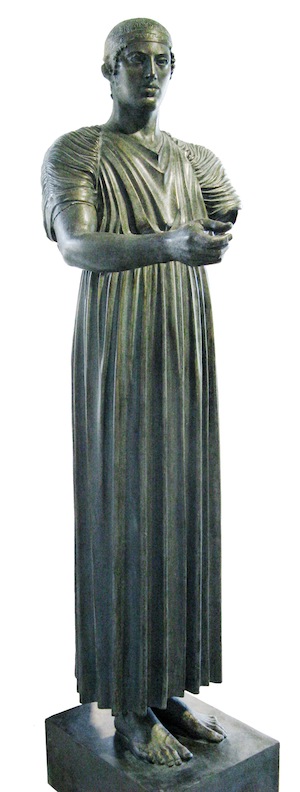The trend toward realism in the depiction of human and animal figures quickened in the brief Transitional period. The rendering of the human body, drapery, and expression is more detailed than is apparent in the Archaic period, but has not yet reached a stage of full-blown naturalism. This period also saw a rise in the construction of elaborate temples adorned with pediments and friezes of bas relief (two-dimensional) sculptures.
“Severe” is the label sometimes attached to Transitional Greek art. In fact, this early naturalism has an air of restraint that has nothing to do with severity. The more lifelike anatomy of statues and foreshortening of reliefs actually constituted a major stylistic shift. The artistic changes of this period eventually gave rise to the striking naturalism of the Hellenistic period.
The pottery painting styles of the sixth century BC, such as red- and black-figure, continued into the Transitional period, though black-figure began to fade out. White-ground pottery, painted fluidly in black and ochre pigments and detailed with fine lines, was a new product of the fifth century.
Sculpture

Charioteer of Delphi
Transitional Greek
replica: from the Louvre, Paris
date of the original: 474 BC
provenance of the original: discovered in 1896 at the Temple of Apollo, Delphi; excavated by the French school at Athens; now in the Museum of Antiquities, Delphi.
description: Standing male figure in chiton, left arm missing below elbow, right arm restored from elbow. Reinforced plaster replica with verdigris finish; bronze original. On base: height 203 cm, width 49 cm, depth 57 cm.
This charioteer was erected at Delphi to commemorate a victory in a chariot race in the Pythian Games, probably in 474 BC, though not to celebrate the charioteer, as we might suppose, but the owner of the chariot and team of four horses. The charioteer was discovered buried in a trench together with bits and pieces of a chariot, reins, four horses and a groom, indicating that originally the charioteer was part of a much larger bronze sculpture.
The driver’s chiton (long robe) is a remarkable achievement in itself with its irregularly but naturalistically distributed folds. Its hemline, a series of arches, creates an optical effect which emphasizes the depth of the folds, while appearing to be a straight line.
It would take much space to describe the other devices applied to produce a truly live figure. Although he is impassive and somewhat stiff, this is partly because his role requires it and also because of the Transitional style, which also contributes to the symmetrical stiffness relieved only by the slight right turn of the head.
Though it might now be considered a trifle, the veins on the charioteer’s feet were particularly admired in ancient times.

Ludovisi Throne
Transitional Greek
replicas: from the Louvre, Paris
date of the originals: c. 476-460 BC
provenance of the originals: Villa Verosini in Rome, where the ancient gardens of Sallust were once located; later moved to the Villa Ludovisi, whence its name (it belonged to the seventeenth-century Cardinal Ludovico Ludovisi). Now in the Musée des Thermes in Rome.
description: Three relief panels. Plaster replicas; marble originals. This sculpture is not a throne and owes its designation to a vague guess at the time of its discovery. It has subsequently been suggested that the three slabs are part of an altar.
Aphrodite/Persephone Panel (top)
Dry or wet, Persephone or Aphrodite, the relief handles problems of foreshortening remarkably well and shows a good but still not perfect understanding of the rendering of folds. The central figure raises some questions in this respect, but not so the subsidiary ones. The face, which is rendered with noble simplicity, is not a portrait but has the typical generic character of the Pre-Classical period.
Hetaera Panel (middle)
It is a remarkable work, anatomically superior to the central slab with the exception of the crossed right leg, which originates out of nothing above the hip. This figure seated on her cushion was given an elegant solution in all its details.
Woman Burning Incense Panel (bottom)
Height 88 cm, width 69 cm, depth 16 cm. The right slab represents a woman burning incense. As a work, she is of the same quality as the flautist, though the calm and chaste scene attracts less attention.
The length of the legs and the visible foot do not seem to be proportional to the rest, something which once again is characteristic of a still exploratory epoch. The folds above the foot are treated in the same way as those of the two women of the Aphrodite panel. The whole of it is therefore an outstanding work attributable to the same chisel.
Pottery

Woman/Maiden Alabastron
Transitional Greek (White-Ground Pottery)
replica: from World Treasures, California
date of the original: c. 480 BC
provenance of the original: now in the National Archaeological Museum, Athens
description: White ground, black figure alabastron (perfume bottle). Short neck, flat brim, cylindrical and pear shaped. Shows two women, one dancing, one seated. Black neck with narrow geometric pattern, repeated on base. Pottery replica; pottery original. Height 17.5 cm, diameter 6.5 cm.
Frequently pottery displayed members of society engaging in their traditional roles. For women this usually meant weaving or spinning, the only variation being war scenes involving the Amazons. Women were considered the more delicate gender in Greek society, and the fine illustration of the white-ground technique leant itself to depictions of fair women.
White-ground also allowed the use of colours not used before in pottery painting, and finer drawing which was achieved by applying white paint over a black glaze and incising the lines to outline the figure.
(See also: Maiden/Muse Lekythos; Lebes Gamikos.)

Terracotta Lekythos
Transitional Greek
original
gift of: Professor Thurston Lacalli
date: c. 500-400 BC
provenance: purchased by donor in 1968-69.
description: Small lekythos with black/brown slip. Height 9.5 cm, diameter 7 cm.
(See also: Maiden/Muse Lekythos.)